Mattresses are one of the most magical items on the planet. They’re the places we go to relax, sleep, recharge, and dream- what’s not to love? Unless it’s an aged mattress with a spring that pokes right in your lower back. Then it’s not quite the comforting sleeping aid we were looking for. Or, some other snoozing horror scenario like mold on a mattress.
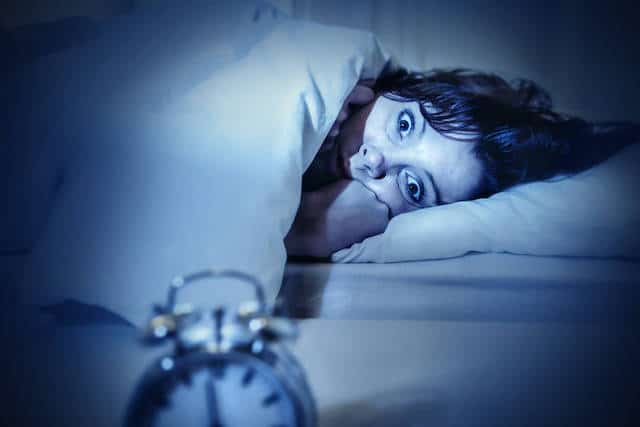
Any unwelcome addition to our bed that’s not there for added protection, like a mattress cover, is pretty much a mattress owner’s nightmare. There you are trying to rest after a long day, minding your own business, and something like mold comes along to join the party. Not only is it a huge pain, but it’s also a health hazard.
Chronic symptoms are probably not what we were looking for when laying down for the night or a nap. Unfortunately, mold in a mattress could happen to anyone, which is why it’s important to know what to do if it happens to you and how to prevent it from occurring in the first place. Knowledge is power, after all. Especially when it comes to a little-discussed topic like mold!
WHAT EVEN IS MOLD?
To get you in the mold on a mattress prevention zone, let’s dive into what this indoor contaminant really is and why we need to avoid it in our homes.
Mold is a type of fungus with over 100,000 species identified so far. Each species reproduces by creating microscopic spores and releasing them into the air.¹’² Thanks to their small size, the spores will fly wherever the wind takes them and hang out on any surface they bump into. If that surface has the components necessary for life, the spores will transition into a growing mold colony. The process is similar to how a place creates seeds. That seed will remain a seed until it’s given the things it needs to grow and turn into a plant.
Similarly, spores will remain spores (which are essentially small particles) until they hit the jackpot of perfect living conditions. Being the hardy fungus that it is, mold spores only need four main components to begin life.³
THESE COMPONENTS ARE:
- Oxygen: this barely counts because they require so little
- Temperature: 40-90 degrees Fahrenheit is preferred
- Food: almost anything is a food source, especially organic matter
- Moisture: the main missing ingredient
If these conditions are met for 24–48 hours, a spore will become a mold colony. Once that mold colony is established, it will begin creating and releasing more spores into the surrounding area.
MOLD IN A HOME
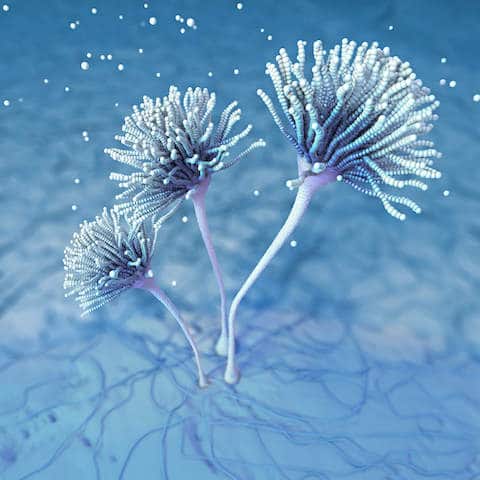
One of the popular misconceptions is that since mold is all over the planet, mold inside of a home is no big deal. That’s not true.
Spores released by mold colonies have the entire planet to disperse through when in nature. With how houses are built nowadays with energy efficiency in mind, there’s very little airflow between the inside and outside of the building. That means that when mold settles into a home and begins releasing spores, all of those particles remain trapped within the walls of the house. This is a much smaller area than the entirety of nature, leading to a higher concentration of particles.
Some species of mold also produce microscopic toxins called mycotoxins when they feel threatened, adding to the volume of particles in the enclosed space.⁴ That’s why indoor mold growth is a problem. Actually, it’s an issue for multiple reasons.
HERE ARE A FEW CONSEQUENCES OF INDOOR MOLD GROWTH:
- Poor indoor air quality
- Contaminated indoor environment
- Exposure to a high volume of foreign particles
- Increased likelihood of another mold problem developing elsewhere in the house
The impact on health is reason enough to prevent indoor growth, such as mold on a mattress.
MOLD ON A MATTRESS SYMPTOMS: THE TOTAL SYSTEMIC EFFECT
Mold’s ability to affect health is partially due to the size of the particles; they’re so small that they’re inhalable. The EPA classifies these kinds of particles as particulate matter and sorts them into two categories, both of which are inhalable.⁵
THE TWO TYPES OF PARTICULATE MATTER ARE:
- PM₁₀: particles with diameters of 10 micrometers (microns) or less
- PM₂.₅: fine particles with diameters of 2.5 micrometers or less
As mold is a key component in nature, and with their particle size allowing them to be blown all over, it’s impossible to completely avoid exposure. Typically, a few particles throughout the day cause no issue. The body will tag them as foreign invaders and deploy the immune system to get rid of them quickly. The key phrase there, though, is “a few.”
When you’re living in a home with one or more moldy problems, you’re not dealing with just a few spores or toxins. You’re battling an entire army of them. Not to mention, when you have mold on a mattress, you’re literally sleeping on a bed of harmful contaminants for however many hours of rest you can squeeze in. Which is about as appealing as it sounds…
The immune system will attempt to keep up and remove all of the foreign invaders, but it can get bogged down and malfunction. This can result in chronic symptoms and allow other autoimmune conditions like Lyme disease, Candida, and the Epstein–Barr virus to flare up and take hold.

SOME OF THE COMMON SYMPTOMS OF MOLD EXPOSURE INCLUDE:
- Hair loss
- Rashes
- Neurological issues
- Mood swings
- Coughing
- Digestive problems
- Watery eyes
- Runny nose
- Chronic fatigue
- Respiratory problems
- Brain fog
At the end of the day, though, everyone reacts differently to exposure, so you never know what symptoms will develop. While one person dealing with mold on a mattress may only have the occasional cough and runny nose, another may develop 25 symptoms that get worse over time. ⁶’⁷’⁸’⁹’¹⁰
Researchers are still attempting to determine exactly how humans respond to mold toxicity, but it’s a tricky subject to nail down. Factors such as genetics, immune system status, species of mold, presence of mycotoxins, presence of bacteria, and length of exposure all play a role.
The potential for any reaction to this indoor contaminant is enough of a reason to prevent issues such as mold on a mattress. So let’s dig in.
WHY IS THERE MOLD ON A MATTRESS?
As stated above, the only things that a mold spore really needs to start growing are food and moisture.
When it comes to food, the mattress components themselves offer a variety of organic edible options. Other food particles can be introduced as well, such as skin cells and dust, which just add to the moldy buffet. That leaves water as the main missing piece a spore needs to transition into a colony. Unfortunately, moisture is an easy addition to a mattress.
A FEW MOIST OPPORTUNITIES ARE:
- Humid indoor conditions
- Spills while drinking a beverage in bed
- Sweating while sleeping
Add in a few things like lack of airflow and types of mattresses like foam that absorb liquid and take longer to dry out, and a mold spore will think it has won the lottery dream home. Remember, all it takes is 24–48 hours for these little particles to start thriving and surviving. Once this occurs, cue the mold on a mattress contamination extravaganza.
THE MOLD ON A MATTRESS LOW-DOWN
Whether you’re creating an action plan in case mold on a mattress happens to you, or you’re dealing with a current problem, here are all the details you need to know.
HOW TO TELL IF YOUR MATTRESS HAS MOLD
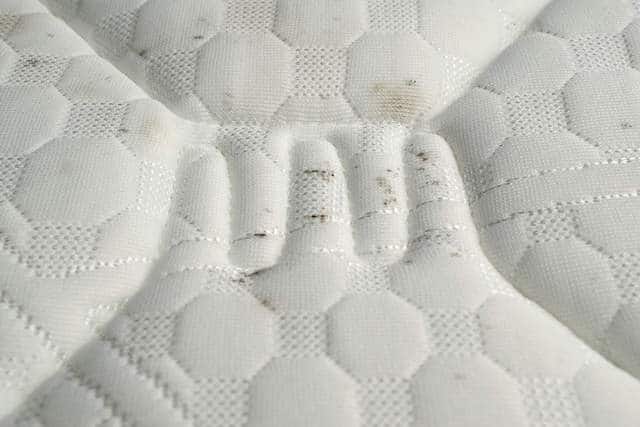
The first step to keeping your bedroom environment safe and your sleep undisturbed by fungus nightmares is to determine if you actually have mold on a mattress. Not all mold growth is visible, especially in porous items such as mattresses, so you’ve got to rely on a few observations.
Number one will be a visual inspection of the entire surface. Any discoloration could indicate a problem. Mold comes in all shapes, sizes, and colors, so any visible blemish is a possible issue. Next, involve your nose. Mold typically creates an earthy, musty, damp smell, so if that’s present, you’re more than likely looking at mold on a mattress.
If neither of these is visible, take a moment to assess how you feel. Your body is an amazing warning system that will alert you if something isn’t quite right. If you’re experiencing chronic symptoms that seem to get worse when you’re laying in bed or after sleeping, that could point to hidden mold growth deep inside the fibers of the mattress.
If any of these observation boxes are checked off, it’s time to start solving the contamination problem. The key to handling mold on a mattress is to maintain the mantra that it’s better to be safe than sorry, especially with wellbeing on the line.
HOW TO GET RID OF MOLD ON A MATTRESS
While there are quite a few tips out there on how to handle mold on a mattress, they’re not all completely accurate. That can leave you staring at a serious indoor contamination issue and scratching your head as to what the right solution really is. This is what you need to know.
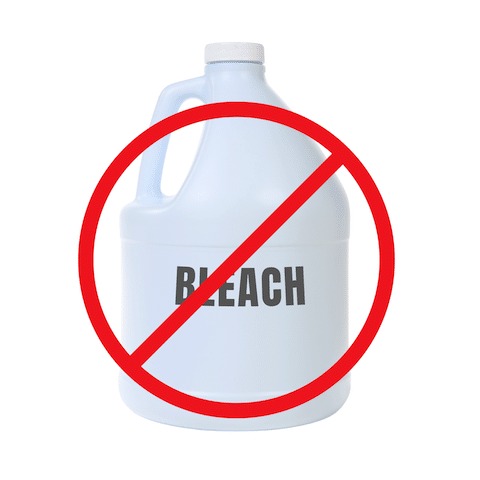
DOES BLEACH KILL MOLD ON A MATTRESS?
No! Even the EPA says that bleach is not the cleaning product you want when dealing with mold.¹¹ This harsh chemical may kill some of the mold (on porous surfaces, this isn’t even a guarantee), but it will leave behind moldy particles on the surface and within the fibers of the mattress. Bleach can also trigger mold to release mycotoxins, which leads to an even larger contamination issue.
WHAT’S A REMEDIATION METHOD THAT WORKS FOR MOLD ON A MATTRESS?
This might not be the news you want to hear, but the best way to handle mold on a mattress is to replace it with a new one.
That’s the only way to ensure you’re not sleeping next to an indoor contaminant all night, every night. If it’s a teeny-tiny spot, you can attempt to clean it with a product such as hydrogen peroxide, but you just never know how deep the contamination issues go.
The issue with mold in a mattress is the porous material of the bed itself. When a mold spore transitions into a living colony, it puts down roots that reach deep into the surface it’s growing on. These can be almost impossible to remove, even with a thorough cleaning protocol.
The small size of the particles is also a problem. Spores and toxins are microscopic, giving them access to all of those porous holes within the mattress. Since they’re invisible to the naked eye, just because you can’t see the contaminants doesn’t mean that they’re not there. Not only that, but they’re also now all over the room the mattress is in because the particles mold releases will catch a ride wherever the air takes them, even into other areas of the home. That’s why mold is so tricky.
Hence, the reason handling mold growth quickly and properly is so crucial. The longer it’s around, the more contamination there will be in the home and the more exposure those living inside will face. Mold on a mattress is a perfect example, considering you spend hours every day sleeping on it.
SO, HERE ARE THE STEPS TO TAKE TO HANDLE MOLD ON A MATTRESS:
- Put on protective gear: A mask and gloves will help protect you from all of the particles that will be kicked up during the process.
- Toss the mattress: Go straight outside with the contaminated bed, do not pass go, and do not collect $200. The longer it’s handled inside, the more particles will get all over the home.
- Deep clean everything: While the colony was growing, it released particles everywhere that are now on all the surfaces of the room. Thoroughly clean everything in the room the mattress was in, as well as the rest of the home, to remove as many particles as possible.
- Turn on an air purifier: This will remove all particles that are airborne from cleaning and moving the mattress.
- Replace with a fresh mattress: Once you’ve thoroughly decontaminated the space, it’ll be safe to replace the mattress with a new one that’s free from mold.
With the new mattress in place, you can then get to work on prevention.
HOW TO PREVENT MOLD ON A MATTRESS
Whether you’re starting fresh with a new bed or just want to make sure yours doesn’t get moldy, there are quite a few steps you can take to prevent mold on a mattress.
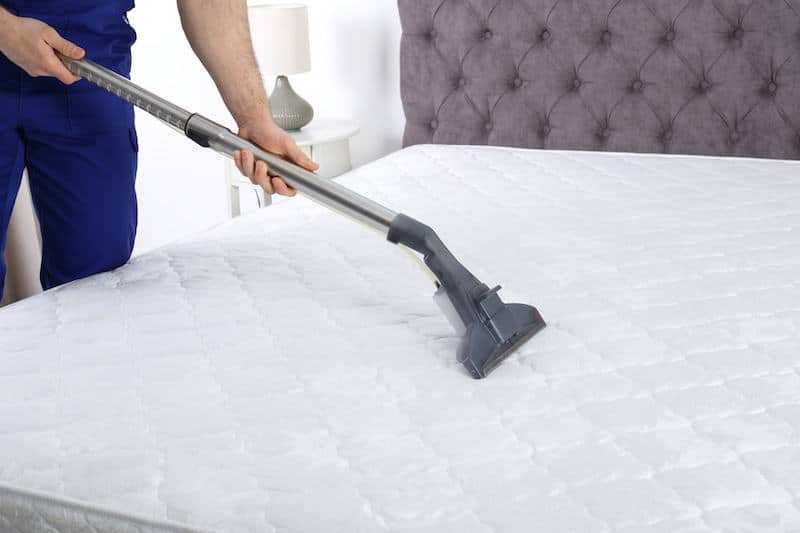
HERE ARE THE TOP ONES TO GET STARTED ON:
- Maintain an indoor humidity level of 30-50%¹²: This can be accomplished by keeping doors and windows closed on rainy/humid days, investing in a dehumidifier, and creating airflow.
- Using a mattress protector: This will protect your mattress from spills, sweat while sleeping, and tiny particles. All of which help promote mold growth.
- Focus on airflow: A mattress with no airflow is a mattress that can stay wet. By allowing air to circulate around the bed, it helps ensure the mattress stays dry. This means not placing the mattress on the floor and opting for a more breathable option such as slats.
- HEPA Vacuum: HEPA filters should filter out particles as small as 0.3 microns 99.7% of the time, at the minimum.¹³ Vacuum both sides of the mattress at least once a month to remove any particles that have found their way in.
- Invest in an air purifier: This amazing machine will remove small particles from the air, like mold spores and toxins. The more that are removed, the lower the chance that they’ll stumble on a nice place inside of your home to grow. Not all air purifiers are built the same, though, so make sure you go with one that removes the smallest particles possible all of the time, not just some of the time.
- Schedule a visual check and flip the mattress: Once a month or so, flip the mattress to help with air circulation and to give it a thorough assessment to make sure mold didn’t manage to somehow start growing. It’s a seriously persistent fungus that will maximize any opportunity present. You can also combine this step with HEPA vacuuming and knock it all out at once.
- Clean up any spills quickly and dry out the mattress asap: A wet mattress can quickly lead to mold on a mattress. If yours happens to get wet for some reason, drop everything, take care of the spill, and make sure that your mattress gets completely aired out.
This preventative list isn’t exhaustive, but it’s a good way to help ensure you get to enjoy sleeping peacefully and don’t deal with mold on a mattress. Preventing this indoor contaminant in our homes is the absolute best way to deal with it in the first place.
THERE WAS MOLD ELSEWHERE IN THE ROOM. WHAT NOW?
This situation is tricky! As mentioned above, colonized mold shoots out particles everywhere. In situations such as these, it’s more of a case-by-case basis.
If you’re experiencing serious adverse health reactions from mold exposure in your home, all of your items could be contaminated. If the symptoms are bad enough, oftentimes the only way to completely detox and heal is to get rid of all of those contaminated items in the home.
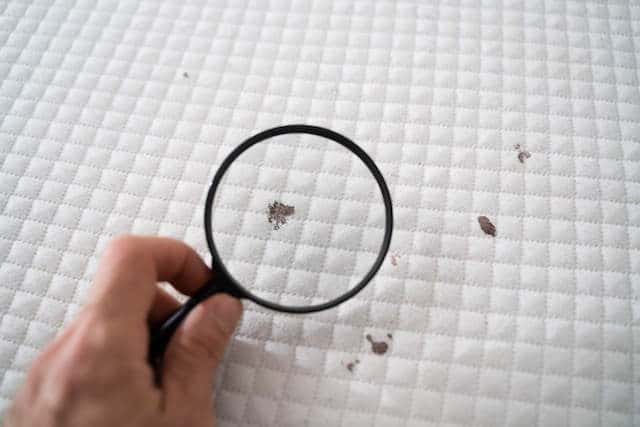
It may seem drastic, but that exposure will continue as long as you’re continuing to be around those harmful particles which can trigger a bodily response.
On the other hand, if you’re not feeling any symptoms and want to attempt to decontaminate your home, you can try to remove any particles on the mattress surface and take it day by day. Since the mattress is porous, cleaning with a cleaning product isn’t always very efficient. Instead, thoroughly and repeatedly HEPA vacuum the entire item and then keep a close eye on it to see if mold begins to grow. Since mold particles are so small, it can take a little while to visibly see mold growth.
Also, pay attention to how you feel. If symptoms start to pop up, the mattress could be contaminated, in which case it’s got to go.
MAKING SURE YOU’RE ACTUALLY GETTING REST
No one wants to go to sleep on a bed filled with harmful particles. Talk about a night filled with terrors… When this fungus among us loves our beds as much as we do, though, mold on a mattress is a very real possibility, and it’s one that we need to avoid.

The steps above may seem like a pain, but they’re a necessary part of keeping our home environments safe. Society may not discuss mold frequently, but that doesn’t mean that exposure can’t drastically affect our health. Keeping yourself and your family safe involves making sure that this fungus doesn’t get the opportunity to move in. And, if it somehow manages to sneak in, having an action plan in place to quickly and properly get rid of it.
Everyone deserves to live in an indoor environment that promotes and supports healthy living. After all, health begins at home.™
Still Have Questions?
A member of our team is here to help! Click on “Get Started ➤” below to book a consultation with a member of the HOMECLEANSE team. We have a few quick questions that will help us put together a roadmap to solve or prevent all of your mold problems.
Two minutes of your time could lead to better health for you and your family.
Must-Have Indoor Air Quality Tools
-

EC3 Laundry Additive
Add EC3 to every rinse cycle to rinse away mold, bacteria and musty odors from...
-
$23.00 Shop Now -

Intellipure Compact Air Purifier
Small in size, but delivers powerful results, reducing airborne microorganisms like mold, viruses, and bacteria.
-
$649.00 Shop Now -

Intellipure SuperV Whole House Air Purifier
Turn your HVAC into a filtration system, removing 99% of ultrafine particles including airborne mold,...
-
Price range: $2,000.00 through $2,995.00 Shop Now -

HomeCleanse Cleaning
Take your cleaning to the next level buying all the tools we use to keep...
-
Price range: $299.00 through $549.00 Shop Now -

Mold & Bacteria Contents Cleaning
Remove harmful pollutants that accumulate in the dust of your home. (Options available for renters...
-
Price range: $99.00 through $349.00 Shop Now -

EC3 Mold Solution Concentrate
Micro Balance EC3 Mold Solution Concentrate is a natural botanical that removes mold spores, bacteria,...
-
$33.00 Shop Now -

Industry-Leading Intellipure Ultrafine 468
The Intellipure® Ultrafine 468 features our proprietary DFS technology, which traps and eliminates potentially harmful...
-
Shop Now -

The Dust Test
The Dust Test is a comprehensive at-home test that helps you identify mold and toxins...
-
$299.00 Shop Now -

EuroClean 4 Gallon Hepa Vacuum
The Euroclean GD930HSP is a 4 Gallon Dry HEPA Vacuum that meets the EPA's standards...
-
$849.00 Shop Now -

AprilAire E080 Professional Dehumidifier Bundle
Includes all the dehumidifier accessories you will need. Our Aprilaire E080 comes with a drain...
-
$1,524.99 Shop Now
